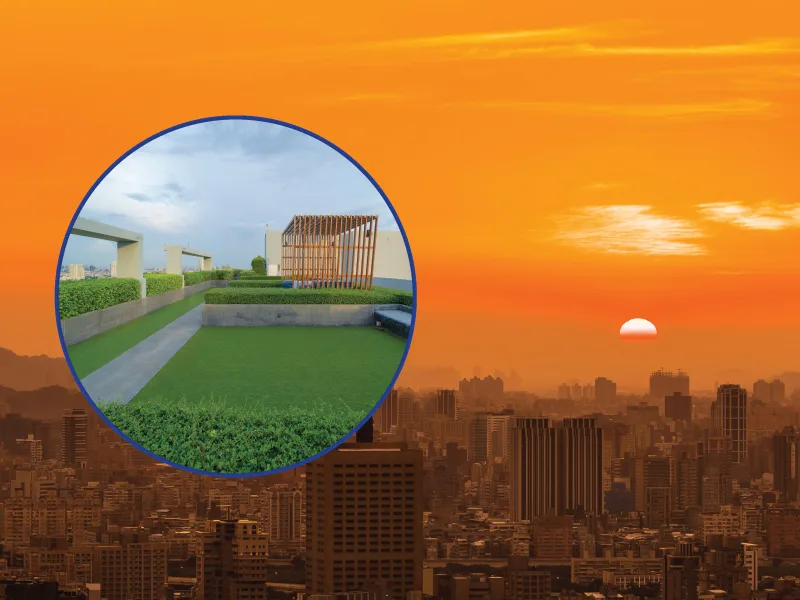Cities are heating up- quite literally, especially in a country like India. Many areas become much warmer than nearby rural places. Credit goes to – more concrete, fewer trees, and tightly packed buildings. This is known as the urban heat island (UHI) effect. It results in discomfort and growing pressure on urban infrastructure. This affects everything from sleep quality to long-term health and energy bills. But some nature-based solutions could help us cool things down- starting from the top.
What Causes Urban Heat Islands?
UHIs are mainly caused by a combination of natural and human-made factors that trap heat in cities. The dense & built-up nature of urban environments exacerbates the issue, leading to temperatures that can be several degrees higher than in surrounding rural areas. Understanding the major key contributors to this effect is really essential for finding effective solutions.
- Heat-absorbing surfaces: Asphalt roads and concrete buildings tend to soak up sunlight all day and then release stored heat at night.
- Reduced greenery: Trees and parks cool the air by shading surfaces and releasing moisture. Many Indian cities have limited tree cover.
- Waste heat: Air conditioners, vehicles, and industrial equipment emit heat into the surroundings.
- Urban geometry: Tall buildings and narrow streets form the “urban canyons” and it limits the airflow and trap heat.
- Loss of water bodies: Rivers, ponds and lakes naturally cool down the nearby areas. But as they vanish or dry up, cities lose another source of relief
Green Roofs: A Solution to the Urban Heat Island Effect
Green roofs which are also known as vegetated or living roofs, are built by layering waterproof membranes, soil media, and plants on top of existing rooftops. They cool down the urban areas by shading the roof surfaces, promoting evapotranspiration and adding insulation. The combined effect lowers both- surface and ambient temperatures. Eventually this results in improving thermal comfort and reducing the demand of cooling-energy.
Globally, green roofs have moved beyond just the niche projects. In Germany, they cover about 17% of all new roof constructions, driven by EU regulations and incentive programs. Washington, D.C., now requires green roofs on larger developments to manage stormwater and combat urban heat. These diverse climates show that how green roofs can be tailored to different urban challenges in different parts of the world.
Green Roofs in India : Feasibility and Policy Support
Recent studies indicate that implementing green roofs in Indian cities like Ahmedabad can lead to pedestrian-level temperature reductions exceeding 0.1°C and energy savings of over 5 kWh/m²/year. Such interventions not only enhance urban comfort but also contribute significantly to energy efficiency goals.
- National guidelines: An addendum to the URDPFI (Urban & Regional Development Plans Formulation and Implementation) highlights green roofs as part of “green infrastructure,” noting their cost-effectiveness for cooling in tropical climates.
- Green‐building credits: The Indian Green Building Council (IGBC) awards UHI-mitigation credits when at least 60% of the exposed roof area is vegetated.
- Builder considerations: Most modern RCC slabs can support extensive green roofs with minimal reinforcement. Key steps include robust waterproofing, drainage design, and selecting low-maintenance plantings
Challenges and Practical Considerations
- Cost Considerations
Initial installation costs can range from ₹300 to ₹1,500 per square foot (Source: housing.com), depending on the system’s complexity and plant choice.The higher upfront costs could be a concern, but long-term savings in energy costs actually make it a worthwhile investment.
- Structural Readiness
Most of the modern buildings can support the green roofs with minimal reinforcement. Proper waterproofing, drainage design and the load capacity assessments are essential to prevent issues such as leaks and ensure durability.
- Maintenance
Green roofs require regular upkeep, including plant care and ensuring proper drainage. Opting for low-maintenance plants can help to reduce the effort as well as the cost of maintaining these green spaces.
Conclusion
As Indian cities continue to heat up, green roofs present a practical & scalable solution that blends modern construction with nature-based thinking. They improve thermal comfort, cut cooling costs and add aesthetic as well as ecological value to urban buildings. With supportive policies and the right construction strategies, builders and homeowners can turn underused rooftops into cool & green assets – one layer at a time.
